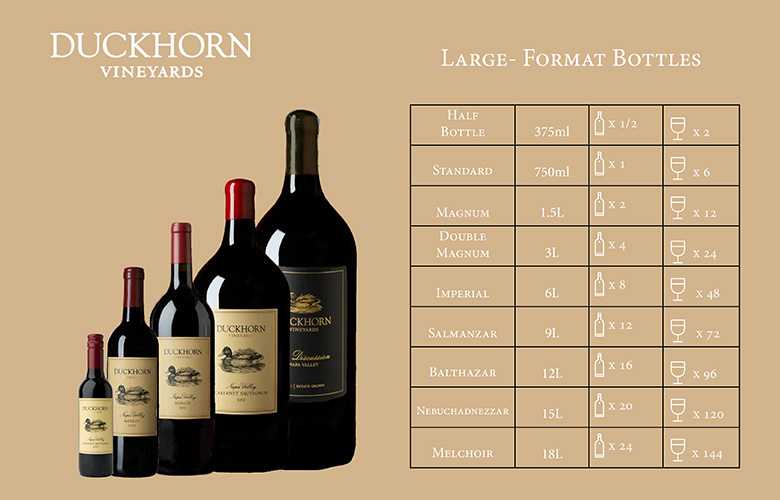How to Enjoy Large-Format Wine Bottles

Uncorking a large-format wine bottle is exciting and ceremonious! These bottles are rare in comparison to the standardized 750ml bottles, and they make for a practical investment. Large-format bottles are perfect for your cellar as they age more gracefully and make for impressive centerpieces during special gatherings. In this blog we are going to explore the evolution and benefits of large format wine bottles.
The Evolution of Wine bottles
It is believed that the ancient Romans, used glass blowing to create wine bottles. Yet, this glass was too delicate to store the wine, so they used amphoras, large clay pots, for wine transport and storage. The glass bottles they created were typically used as a decanter for dinners. In the 1700’s, coal-burning furnaces allowed for higher heat and allowed glass blowers to create thicker and darker glass. The production of the cork closure came shortly after and with that changes in wine bottle shape and size began to take form. It was discovered that the larger the bottle, the slower and more gracefully it ages. In, 1979, the United States deemed the 750ml the standardized wine bottle size, and the European Union followed suit, in order to ease trade.
Collecting Large-Formats for your Cellar
Large-format wine bottles make the perfect addition to your cellar due to their age-ability. The aging and oxidation process in a large-format bottle occurs more slowly, than the standardized 750ml, creating a wine with an enhanced flavor profile. With age the tannins soften, and the wine begins to express secondary and tertiary aromas creating a more complex wine.
So, the larger the bottle, the more age-ability. This is because the ullage, or oxygen sealed in each bottle of wine is the same despite differing bottle sizes. With larger formats, there is a larger volume of liquid interacting with that oxygen. In addition, large-formats are more resistant to drastic temperature variations and light damage due to the higher volume of liquid. For those interested in making practical wine investments, large-format bottles are your best option for cellaring and aging.
Celebrating with a Large-Format
Social gatherings are the perfect occasion for uncorking a large-format! Whether it’s for a holiday dinner, a family get-together, wedding or graduation, a large-format is sure to impress. Opening large-formats can take a little practice. So, we assembled a few suggestions:
- Carefully, cut the wax off a large-format same as you would on a standard bottle with foil. Your cork screw knife should work great or even a serrated knife. Peel away the wax and be careful not to get any in the bottle.
- If you are opening an older vintage wine, the ah-so wine opener is perfect solution. Vintage corks are delicate and the last thing you want is to destroy your large-formats cork. We suggest adding a neutral oil to the prongs to easily glide into the bottle neck and be cautious not to push the cork in. Simply twist and pull to cleanly extract the cork.
- Once, you have uncorked your large-format, wipe away any sediment in the neck and decant your wine. Pouring from a large-format can be cumbersome, so the decanter is great way to ceremoniously present the wine while allowing the sediment to sit in the bottle and not your glass while at-the-same-time aerating the wine.
